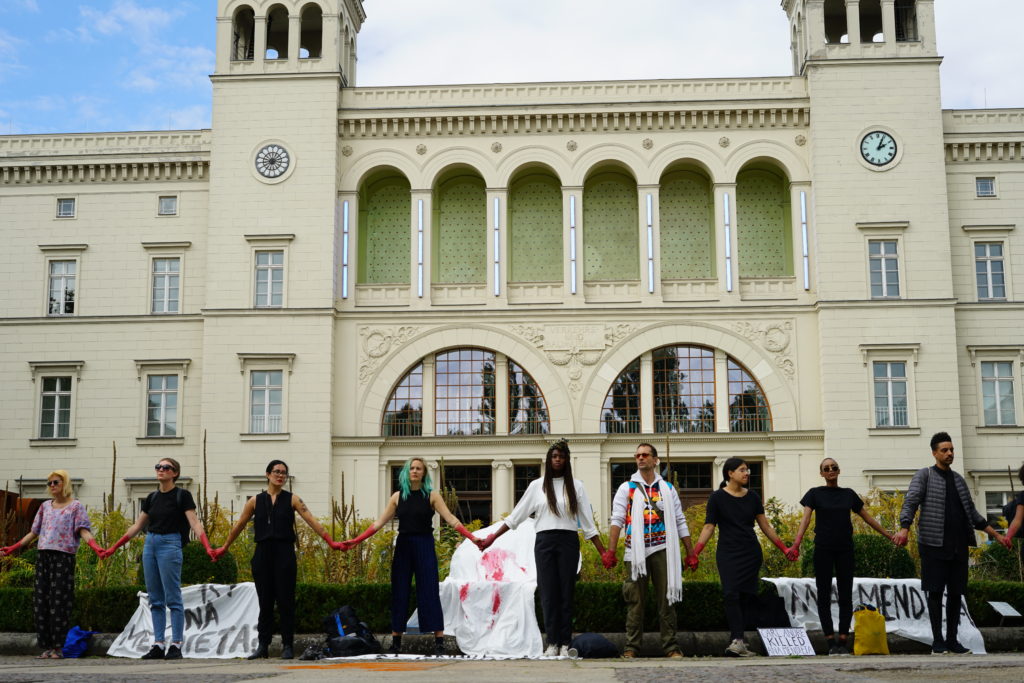Global activist group Where is Ana Mendieta? staged another action on Sunday, September 18 at Berlin’s Hamburger Bahnhof. It was one carried out in memory of the titular Cuban-born artist Ana Mendieta best known for her earth-body works, who fell to her death in September 1985 at the age of 36. Since then, feminist demonstrators have been protesting institutions through direct actions and ‘cry-ins’ for exhibiting the work of her husband at the time, Carl Andre, who was charged and controversially acquitted of her murder following the incident. According to the group, the institutional world has ignored the contention surrounding Mendieta’s death, while also failing to recognise her work in favour of Andre’s —she was a pioneer in the 80s performance art movement of New York, gathering momentum around feminism outside of white middle-class American infrastructures. Mendieta would have been 67-years-old today and doubtless a great contributor to contemporary discourse, given her already prolific body of work, perhaps even more ground-breaking than Andre.
Following a similar protest at London’s Tate Modern in June, this Where is Ana Mendieta? event took place in front of the Berlin museum, marking the final day of Andre’s retrospective exhibition Sculpture as Place, 1958-2010.

At 13.30 the demonstration —including women, men and non-binary people —filed through the main gate of Hamburger Bahnhof holding hand-painted banners reading, “Where is Ana Mendieta?”, “Carl Andre killed Ana Mendieta” and “Stop glorifying violent men”. The sounds of cellos, crying and bells played from their mobile phones and hand-held speakers —a new media take on the original cry-in demonstrations held at Newburgh, New York’s Dia:Beacon in 2015. Their hands and wrists were covered in red paint, symbolic of Mendieta’s signature style from her Body Trace series in the 1970s. Six figures carried a white sheet, tomb-like, with the trace of a vivid red body printed on it —a belated but symbolic funeral procession for the artist’s death that has been largely ignored. A few people worked their way through the visitors to the museum stamping their wrists with the slogan “Where is Ana Mendieta?”, questioning the idea of who belongs and who is granted access to the institution.
The lack of institutional discourse and mystery surrounding the artist’s death is one of the reasons for the continuation of these protests 31 years later: An article in the New York Magazine in December 1985 points towards a case of domestic violence from Andre, as well as a testimony of guilt from a doorman, along with other circumstantial evidence. But a trial that spanned over the course of three years, resided over by only one judge rather than a jury —a rarity in murder cases —and with inconclusive police evidence exculpated Andre. Mendieta’s art was used in the trial as proof of a suicidal tendency, regarded by some as a misuse of her work and conceptual ideology.

The protesters created a timeless chain around the courtyard of Hamburger Bahnhof’s main entrance, silently they held hands, as onlookers watched and listened to the cries emitting from their iPhones. Tears ran down the cheeks of every other protester as the organisers of the action read statements on Mendieta’s life, work and death, along with poems drawing attention to women whose lives have been cut short by cruel circumstances —the phrase ‘say her name’ was alluded to in a poem, extrapolating on the point of remembrance. Information sheets were handed out in English, German, Spanish and Turkish explaining the life and work of the artist and why still today people are asking the question, “Where is Ana Mendieta?”.**















